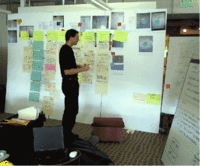For example, "throwing" something, such as requirements, "over the wall" is considered bad, since it often means a lack of advisable collaboration or partnership preceding or following the throwing.
Such walls imply a strict division of ownership, which the User eXperience network's Executive Council (including yours truly) have argued might be inappropriate:
"Who owns user experience (UX)? This is the wrong question to ask. We don't believe any single group can own UX.But walls can actually contribute greatly to the advocated collaboration.
What's the alternative? In our view, a useful focus is collaboration, not ownership. The best successes come from collaboration. Whatever type of product, service, or document you are creating, whether it's a Web site, an application program, an MP3 player, or a financial form, user experience encompasses so many diverse aspects of your product that 'ownership' just isn't a useful perspective. UX is about providing value to your customer and the business serving that customer. The best user experience is the product of many different disciplines working together."
(from the May+June 2005 special issue of interactions entitled, "Whose profession is it anyway?")
For example, using walls as a work surface can greatly facilitate collaboration. And this facilitation can have a long and powerful life if the work on the walls can remain over time, particularly if it provides an immersive workspace that continually informs and guides the work.
Judy Olson and colleagues describe how such a use of walls can be beneficial in a CHI conference paper entitled, "A room of your own: What would it take to help remote groups work as well as collocated groups?":
"Collocation of cognitive artifacts and team members offers the broadest bandwidth for cooperative work. Team members developed shared documents together, making the work tangible. Artifacts helped coordination and motivation as well. The key feature was that they were persistent, allowing easy access (by a glance, not a file retrieval) and large enough to allow cross connections to be perceived. The presence of one's co-workers helped with coordination, implicit learning, easy transitions from one phase of work to another, and social facilitation."
 Such use of walls was critical to our collaborative work in Viant's Experience Center (see photo) and has been critical to the collaborative work of many others (for example, see Marc Rettig's documentation of the many ways walls were used to facilitate collaboration at HannaHodge and on a project described at DUX 2003).
Such use of walls was critical to our collaborative work in Viant's Experience Center (see photo) and has been critical to the collaborative work of many others (for example, see Marc Rettig's documentation of the many ways walls were used to facilitate collaboration at HannaHodge and on a project described at DUX 2003).But even walls of ownership can contribute to the quality and appropriateness of the collaboration involved in designing for user experience. As the editors of interactions state in that special issue referenced above:
"Attributing responsibility or accountability is different than attributing participation: We believe that UX (user experience) is by its nature collaborative. Working with multi-disciplinary teams is a significant part of our work life.
...(However,) product management doesn't build or design products: their job is to own product vision and strategy (naturally with the other stakeholders' input). Engineers own code development and code quality, with a wide range of specialties (architecture, code design, QA, and release management, to name a few). Product marketers take clear ownership of marketing communications and product campaigns, keeping the pulse of the marketplace, and trying to detect what it will buy. Therefore, it's only logical that human-computer interaction professionals take ownership of the user experience. We are, after all, user experience experts, despite the fact that we depend on other development participants to meet user and business needs."
